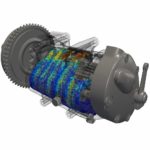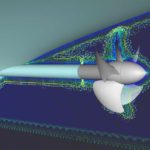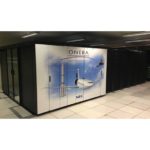Over at CSCS, Simone Ulmer writes that researchers at ETH Zurich have clarified the previously unresolved question of whether fish save energy by swimming together in schools. They achieved this by simulating the complex physics on the supercomputer ‘Piz Daint’ and combining detailed flow simulations with a reinforcement learning algorithm for the first time. “In their simulations, they have not examined every aspect involved in the efficient swimming behavior of fish. However, it is clear that the developed algorithms and physics learned can be transferred into autonomously swimming or flying robots.”
Case Study: Supercomputing Natural Gas Turbine Generators for Huge Boosts in Efficiency
Hyperion Research has published a new case study on how General Electric engineers were able to nearly double the efficiency of gas turbines with the help of supercomputing simulation. “With these advanced modeling and simulation capabilities, GE was able to replicate previously observed combustion instabilities. Following that validation, GE Power engineers then used the tools to design improvements in the latest generation of heavy-duty gas turbine generators to be delivered to utilities in 2017. These turbine generators, when combined with a steam cycle, provided the ability to convert an amazing 64% of the energy value of the fuel into electricity, far superior to the traditional 33% to 44%.”
Understanding Behaviors in the Extreme Environment of Natural Gas Turbine Generators
“With these advanced modeling and simulation capabilities, GE was able to replicate previously observed combustion instabilities. Following that validation, GE Power engineers then used the tools to design improvements in the latest generation of heavy-duty gas turbine generators to be delivered to utilities in 2017. These turbine generators, when combined with a steam cycle, provided the ability to convert an amazing 64% of the energy value of the fuel into electricity, far superior to the traditional 33% to 44%.”
Altair acquires FluiDyna CFD Technology for GPUs
Altair has acquired Germany-based FluiDyna GmbH, a renowned developer of NVIDIA CUDA and GPU-based Computational Fluid Dynamics (CFD) and numerical simulation technologies in whom Altair made an initial investment in 2015. FluiDyna’s simulation software products ultraFluidX and nanoFluidX have been available to Altair’s customers through the Altair Partner Alliance and also offered as standalone licenses. “We are excited about FluiDyna and especially their work with NVIDIA technology for CFD applications,” said James Scapa, Founder, Chairman, and CEO at Altair. “We believe the increased throughput and lower cost of GPU solutions is going to allow for a significant increase in simulations which can be used to further impact the design process.”
ScaleMP Powers Largest Shared-Memory Systems in Canada
ScaleMP announced that the government of Canada has extended the contract for its large shared memory systems acquired from Dell. These SMP systems use vSMP Foundation to aggregate more than 64 Intel Xeon processors each, totaling more than 1500 CPUs per system. The systems are used for a variety of HPC workloads, including computer-aided engineering (CAE) and computational fluid dynamics (CFD). “Together with our hardware partners, we have been providing technology to the government of Canada since 2012, and are proud of repeatedly earning their business,” said Shai Fultheim, founder and CEO of ScaleMP. “repeat customers are a big part of the vSMP Foundation user community, and we continue to see expansion of our footprint with existing customers along with strong growth in deployments of vSMP Foundation with new ones.”
New Pointwise Release Adds Mesh Automation and Adaptability for CFD
Pointwise has released Version 18.1, a major update to its computational fluid dynamics (CFD) mesh generation software. With its origins in a multiyear development effort funded by the U.S. Air Force for overset grid assembly, this latest Pointwise release includes a suite of tools that provide increased automation and flexibility in mesh topology creation, mesh types and mesh quality assessment. “This release is the culmination and commercial manifestation of a two-year $1.2 million research and development effort funded by the U.S. Air Force Materiel Command, Arnold Engineering Development Complex,” said Nick Wyman, Pointwise’s director of applied research. “That effort in turn was an extension of a previous, two-year, Small Business Innovation Research (SBIR) Phase II award. While focused on overset grid assembly, the capabilities added to the software are applicable to virtually any type of mesh generation.”
Porting Scientific Research Codes to GPUs with CUDA Fortran
Josh Romero from NVIDIA gave this talk at the Stanford HPC Conference. “In this session, we intend to provide guidance and techniques for porting scientific research codes to NVIDIA GPUs using CUDA Fortran. The GPU porting effort of an incompressible fluid dynamics solver using the immersed boundary method will be described. Several examples from this program will be used to illustrate available features in CUDA Fortran, from simple directive-based programming using CUF kernels to lower level programming using CUDA kernels.”
RCR uses Simulation to Accelerate Racecar Development
Richard Childress Racing (RCR) is hoping to improve racing times through a multi-year partnership with ANSYS. RCR will use ANSYS Pervasive Engineering Simulation software to more accurately predict machine performance and enhance vehicle speed on the race track. “Using ANSYS Pervasive Engineering Simulation throughout the entire racecar lifecycle, RCR will race faster, safer and more aerodynamic vehicles.”
Unstructured-Grid CFD Algorithms at NASA on Volta GPUs
Eric Nielsen from NASA gave this talk at SC17 in Denver. “In the field of computational fluid dynamics, the Navier-Stokes equations are often solved using an unstructured-grid approach to accommodate geometric complexity. Furthermore, turbulent flows encountered in aerospace applications generally require highly anisotropic meshes, driving the need for implicit solution methodologies to efficiently solve the discrete equations. To prepare NASA Langley Research Center’s FUN3D CFD solver for the future HPC landscape, we port two representative kernels to NVIDIA Pascal and Volta GPUs and present performance comparisons with a common multi-core CPU benchmark.”
NEC Deploys Sator Supercomputer at ONERA in France
NEC has deployed a new supercomputer at the ONERA center in France to power aerospace research. Called SATOR, the 667 Teraflop machine features Intel Broadwell E5-2680v4 processors and the Intel Omni-Path interconnect. “According to NEC, ONERA plans to upgrade the machine to 1.14 Petaflops peak sometime later this year.”












